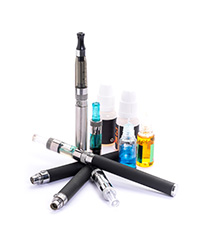
Why vaping is healthier than cigarette smoking?
This is why using vaping liquid is a far better option. Vape juices contain far fewer chemicals and are FDA approved. Before using a particular vaping liquid, be sure to check out the ingredients to ensure it is high-quality. Vaping is Less Addictive. The high nicotine levels in traditional cigarettes make it extremely hard for people to quit ...
How dangerous is vaping compared to smoking?
Vaping is safer than smoking cigarettes! However, it doesn’t change the fact that you are still inhaling a lot of bad stuff into your lungs. Vapes contain A LOT LESS chemicals than your traditional nicotine cigarette. When smoking a cigarette, you’re smoking a lot of stuff, including Carbon Monoxide, which can harm your blood cells.
Is vaping worse than smoking a cigarette?
Vaping May Be More Dangerous Than Cigarette Smoking, Studies Show. Some people take up vaping – or inhaling vapor from electronic cigarettes – to avoid the health hazards of smoking cigarettes made with tobacco.
Why is vaping better for you than smoking?
Vaping yields better flavor than smoking. Vaping gives you a better taste of the flavonoids, and you’re able to feel the flavors of the different brands of marijuana products you’re vaping. Therefore, vaping delivers a richer and purer vapor, unlike smoking, which produces several other substances that mask the flavors of your joint.

How old do you have to be to sell e-cigarettes?
Enforce the new federal law that raised the minimum age for sale of tobacco products from 18 to 21 years.
Why do young people use e-cigarettes?
Many young people say they’ve tried e-cigarettes in part because of the appealing flavors. More than 80% of teen users say their first e-cigarette product was flavored.
What do tobacco companies want to do?
Tobacco companies want to hook a new generation on nicotine and smoking.
Is vaping bad for health?
E-cigarettes’ biggest threat to public health may be this: The increasing popularity of vaping may “re-normalize” smoking, which has declined for years. Reversing the hard-won gains in the global effort to curb smoking would be catastrophic. Smoking is still the leading preventable cause of death and is responsible for 480,000 American lives lost each year.
Is vaping harmful to you?
The American Heart Association recommends proven methods to successfully quit smoking. Many people think vaping is less harmful than smoking.
Can vaping harm a pregnant woman?
Most e-cigarettes deliver nicotine, which is highly addictive and can harm the developing brains of teens, kids and fetuses in women who vape while pregnant. Some types expose users to even more nicotine than traditional cigarettes.
Can you use e-cigarettes if you don't smoke?
People who do not currently smoke or use tobacco products should not use e-cigarettes.
What percentage of teens use vaping?
According to survey data collected between 2014 and 2017, 9% of middle and high schoolers reported that they were current vaping users. Vaping was most common among Native Hawaiian and Pacific Islanders (18%), as well as American Indian and Alaskan Native teens (13%). About 10% of White and Hispanic teens vaped, and vaping was least common among Black (5%) and Asian teens (4%).18 The percentage of teens who reported vaping doubled between 2017 and 2019.19 In 2019, about 28% of highschoolers and 11% of middle schoolers reported e-cigarette use. Most teens who vaped reported that they used flavored products.20 Two 2020 surveys found that the percentage of students vaping decreased early in the year. A CDC study analyzing data from the National Youth Tobacco Survey, a study of over 14,000 students, found that about 20% of 9th-12th grade students and 5% of 6th-8th grade students reported that they used e-cigarettes in the last 30 days.21 A different survey conducted by researchers from the University of Michigan, funded by the National Institute on Drug Abuse, studied over 8,000 students in only the 10th and 12th grades, and found that 22% reported vaping in the last 30 days.22 Although these numbers are still high, and comparable to the statistics in 2018,17 they are notably lower than 2019. E-cigarette use may have dropped due to growing awareness of the dangers of these products, including media coverage of young men hospitalized with serious lung damage.22,23 The drop may also be due to raising the legal age for the purchase of tobacco products and the ban on flavored products.22,24
What is the FDA's guide to e-cigarettes?
The Director of Communications at the FDA’s Center for Tobacco Products has written this guide to help parents identify these hidden e-cigarettes. The FDA has also helped create this pamphlet for parents and teens to discuss the risks of vaping, and it provides resources for saying “no” and for quitting.
What are E-cigarettes?
E-cigarettes are battery-operated devices that were initially shaped like cigarettes, but now include vape mods, Juuls, and vape pens. Some look like flash drives or highlighter pens, making it easy for teens to hide them in plain sight. The brand-name products contain nicotine, an addictive drug that is naturally found in tobacco and that stimulates, causes stress during withdrawal, and then feels relaxing as continued exposure follows withdrawal. It is the nicotine in cigarettes that makes smoking so addictive, and the same is true for most vaping and juuling. These electronic products allow nicotine to be inhaled, and they work by heating a liquid cartridge containing nicotine, flavors, and other chemicals into a vapor. Because e-cigarettes heat a liquid instead of tobacco, what is released is considered smokeless.3
How do electronic cigarettes work?
These electronic products allow nicotine to be inhaled, and they work by heating a liquid cartridge containing nicotine, flavors, and other chemicals into a vapor. Because e-cigarettes heat a liquid instead of tobacco, what is released is considered smokeless.3.
Why did the e-cigarette market drop?
E-cigarette use may have dropped due to growing awareness of the dangers of these products, including media coverage of young men hospitalized with serious lung damage. 22,23 The drop may also be due to raising the legal age for the purchase of tobacco products and the ban on flavored products.22,24.
Is vaping harmful to DNA?
Although there are clearly serious dangers from vaping, more research is needed to confirm the impact of vaping on DNA damage, especially in children. Meanwhile, claims that e-cigarettes are an effective strategy to quit smoking are not supported by the evidence thus far.
Which tobacco companies have their own e-cigarettes?
The big three tobacco companies—Lorillard, Reynolds American, and Altria Group —all have their own e-cigarette brands, so it’s not surprising that e-cigarettes are being marketed and advertised much the way regular cigarettes used to be. Here are the 7 Ways E-Cigarette Companies Are Copying Big Tobacco’s Playbook.
How many studies have been published about e-cigarettes?
There are over 150 published studies about e-cigarette toxicity, chemical composition, effects on the human body, and cessation. Every month, as the scientific literature grows supporting e-cigarettes as being far less hazardous than smoking, the support for harm reduction policies among public health and tobacco control advocates grows as well. Indeed, in 2013 more than 50 scientific experts signed a letter to the World Health Organization calling vapor products “among the most significant health innovations of the 21st century — perhaps saving hundreds of millions of lives.”
Can nicotine gum be used as a long term substitute for smoking?
Medicines and Healthcare Products Regulatory Agency recommend nicotine replacement therapy products like the nicotine gum and patch as long-term substitutes or smoking.
Can you smoke for nicotine but die from the tar?
In 1976, Professor Michael Russell wrote in the British Medical Journal, “People smoke for nicotine but they die from the tar.” In the near-40 years since that statement was made, very little has changed in the scientific literature. There is wide agreement in the field of nicotine and tobacco research that compared to the hazards of inhaling burning smoke into the lungs, smoke-free nicotine use is not a sizable threat to health (except for those who are pregnant or with rare conditions). In fact, both the U.S. Food and Drug Administration and the U.K. Medicines and Healthcare Products Regulatory Agency recommend nicotine replacement therapy products like the nicotine gum and patch as long-term substitutes or smoking.
Is vapor cigarette safer than smoking?
A: Even the most ardent of e-cigarette and vapor product opponents generally concede that all scientific evidence points to vapor products being far less hazardous than smoking cigarettes . Even Mitch Zeller, Deputy Director of the Center for Tobacco Products of the Food & Drug Administration has commented, “If we could get all of those people [who smoke] to completely switch all of their cigarettes to noncombustible [e-]cigarettes, it would be good for public health.”
Which is more likely to use e-cigarettes: youth or adults?
In the United States, youth are more likely than adults to use e-cigarettes.
What are the chemicals in e-cigarettes?
Cancer-causing chemicals. Heavy metals such as nickel, tin, and lead 1. It is difficult for consumers to know what e-cigarette products contain. For example, some e-cigarettes marketed as containing zero percent nicotine have been found to contain nicotine. 2.
How do e-cigarettes produce aerosols?
E-cigarettes produce an aerosol by heating a liquid that usually contains nicotine—the addictive drug in regular cigarettes, cigars, and other tobacco products—flavorings, and other chemicals that help to make the aerosol. Users inhale this aerosol into their lungs.
What does an e-cigarette look like?
Some e-cigarettes are made to look like regular cigarettes, cigars, or pipes. Some resemble pens, USB sticks, and other everyday items. Larger devices such as tank systems, or “mods,” do not resemble other tobacco products. Using an e-cigarette is sometimes called “vaping.”.
Is e-cigarette smoke harmful?
1 E-cigarette aerosol can contain chemicals that are harmful to the lungs. And youth e-cigarette use is associated with the use of other tobacco products, including cigarettes.
Is nicotine poisonous to children?
In addition, acute nicotine exposure can be toxic. Children and adults have been poisoned by swallowing, breathing, or absorbing e-cigarette liquid through their skin or eyes. E-cigarettes are still fairly new, and scientists are still learning about their long-term health effects.
Is nicotine bad for pregnant women?
Nicotine is a health danger for pregnant adults and their developing babies.
Why are e-cigarettes so popular?
First, many teens believe that vaping is less harmful than smoking. Second, e-cigarettes have a lower per-use cost than traditional cigarettes.
How many people died from vaping in 2020?
As of Jan. 21, 2020, the Centers for Disease Control and Prevention (CDC) confirmed 60 deaths in patients with e-cigarette, or vaping, product use associated lung injury (EVALI).
How many chemicals are in e-cigarettes?
E-cigarettes heat nicotine (extracted from tobacco), flavorings and other chemicals to create an aerosol that you inhale. Regular tobacco cigarettes contain 7,000 chemicals, many of which are toxic. While we don’t know exactly what chemicals are in e-cigarettes, Blaha says “there’s almost no doubt that they expose you to fewer toxic chemicals than traditional cigarettes.”
How many people want to quit smoking?
If you have thought about trying to kick a smoking habit, you’re not alone. Nearly 7 of 10 smokers say they want to stop. Quitting smoking is one of the best things you can do for your health — smoking harms nearly every organ in your body, including your heart. Nearly one-third of deaths from heart disease are the result of smoking and secondhand smoke.
Is vaping bad for you?
Is vaping bad for you? There are many unknowns about vaping, including what chemicals make up the vapor and how they affect physical health over the long term . “People need to understand that e-cigarettes are potentially dangerous to your health,” says Blaha. “Emerging data suggests links to chronic lung disease and asthma, and associations between dual use of e-cigarettes and smoking with cardiovascular disease. You’re exposing yourself to all kinds of chemicals that we don’t yet understand and that are probably not safe.”
Is nicotine a substance?
Nicotine is the primary agent in both regular cigarettes and e-cigarettes, and it is highly addictive. It causes you to crave a smoke and suffer withdrawal symptoms if you ignore the craving. Nicotine is also a toxic substance. It raises your blood pressure and spikes your adrenaline, which increases your heart rate and the likelihood of having a heart attack.
Can you use THC in a vape?
The CDC recommends that people: Do not use THC-containing e-cigarette, or vaping, products. Avoid using informal sources, such as friends, family or online dealers to obtain a vaping device. Do not modify or add any substances to a vaping device that are not intended by the manufacturer.
What are the benefits of e-cigarettes?
What‘s the bottom line? 1 E-cigarettes have the potential to benefit adult smokers who are not pregnant if used as a complete substitute for regular cigarettes and other smoked tobacco products. 2 E-cigarettes are not safe for youth, young adults, and pregnant women, as well as adults who do not currently use tobacco products. 3 While e-cigarettes have the potential to benefit some people and harm others, scientists still have a lot to learn about whether e-cigarettes are effective for quitting smoking. 4 If you’ve never smoked or used other tobacco products or e-cigarettes, don’t start. 5 Additional research can help understand long-term health effects.
What do e-cigarettes look like?
Some e-cigarettes look like regular cigarettes, cigars, or pipes. Some look like USB flash drives, pens, and other everyday items. Learn more about e-cigarettes and their effect on your health. The use of e-cigarettes is unsafe for kids, teens, and young adults.
What is the purpose of the e-cigarette pamphlet?
This product is intended for educational purposes only for public health officials and healthcare providers. The devices and brands presented in this pamphlet are intended to highlight the different e-cigarette, or vaping, product generations and substances used in these devices.
Can you quit smoking with e-cigarettes?
While e-cigarettes have the potential to benefit some people and harm others, scientists still have a lot to learn about whether e-cigarettes are effective for quitting smoking. If you’ve never smoked or used other tobacco products or e-cigarettes, don’t start. Additional research can help understand long-term health effects.
Can you smoke e-cigarettes while pregnant?
E-cigarettes have the potential to benefit adult smokers who are not pregnant if used as a complete substitute for regular cigarettes and other smoked tobacco products. E-cigarettes are not safe for youth, young adults, and pregnant women, as well as adults who do not currently use tobacco products. While e-cigarettes have the potential ...

Many downsides. Few Potential upsides.
A Threat to Kids and Young people.
- Tobacco companies want to hook a new generation on nicotine and smoking. 1. They spent more than $8.6 billion on aggressive marketing in 2017 alone. That’s more than $23 million each day and almost $1 million every hour! 2. Nearly 80% of middle and high school students — that’s 4 out of 5 kids — were exposed to e-cigarette advertising in 2016. 3. E-cigarettes are now the most co…
More Effort and Research Are Needed.
- The Surgeon General called e-cigarette use among young people a “public health concern.” The American Heart Association shares that view. That’s why we advocate for stronger regulations that: 1. Include e-cigarettes in smoke-free laws. 2. Regulate and tax e-cigarettes in the same way as all other tobacco products. 3. Remove all flavors, including m...
What’s The Bottom Line?
- Kids, young people and pregnant women should not use or be exposed to e-cigarettes.
- People trying to quit smoking or using tobacco products should try proven tobacco cessation therapies before considering using e-cigarettes, which have not been proven effective.
- People who do not currently smoke or use tobacco products should not use e-cigarettes.